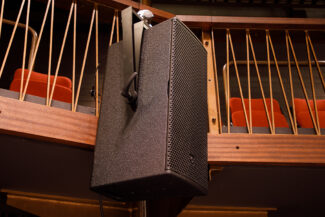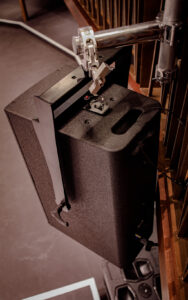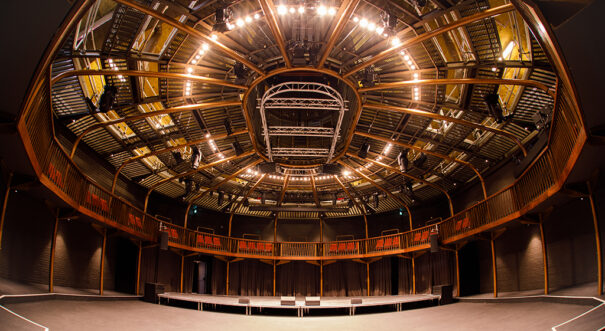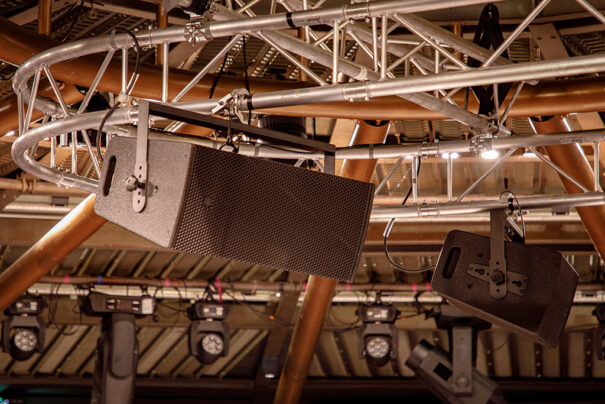The Albany actualiza su sistema de sonido con la serie Reference de EM Acoustics
El sistema está integrado por diferentes sistemas de EM Acoustics. Consta de cuatro R10, dos subwoofers S-15 y dos S-215, cuatro EMS-61 y ocho monitores de escenario M-C12. La potencia se suministra a través de un DQ20, un DQ10 y tres amplificadores DQ6.
 El centro artístico multidisciplinar The Albany ha sustituido recientemente su antigua megafonía por un nuevo sistema de la serie Reference of EM Acoustics suministrado por Stage Electrics.
El centro artístico multidisciplinar The Albany ha sustituido recientemente su antigua megafonía por un nuevo sistema de la serie Reference of EM Acoustics suministrado por Stage Electrics.
Situado en el corazón de Lewisham, en el sureste de Londres, The Albany lleva más de cien años al servicio de su comunidad. El edificio original se inauguró en 1899 con el objetivo de mejorar la vida de la población local y en la década de los 70 se convirtió en el Albany Empire en la década de 1970 y se ganó una reputación por su trabajo pionero en las artes comunitarias radicales.
In 1978 el edificio fue destruido por un incendio. Más tarde fue reconstruido y hoy es un teatro redondo que acoge una enorme variedad de disciplinas, desde música de todo tipo hasta teatro, espectáculos infantiles, talleres y conferencias.
 El jefe de producción del Albany, Ben Stephen, explica que el requisito principal a la hora de especificar su nuevo sistema era la flexibilidad y la facilidad de uso. “Buscamos muchas opciones diferentes, pero el momento Eureka llegó cuando Ed Kinsella, de EM Acoustics, nos visitó con los R10 y algunos EMS Series. Estudiamos todas las ubicaciones de los altavoces y probamos todo tipo de combinaciones y configuraciones”.
El jefe de producción del Albany, Ben Stephen, explica que el requisito principal a la hora de especificar su nuevo sistema era la flexibilidad y la facilidad de uso. “Buscamos muchas opciones diferentes, pero el momento Eureka llegó cuando Ed Kinsella, de EM Acoustics, nos visitó con los R10 y algunos EMS Series. Estudiamos todas las ubicaciones de los altavoces y probamos todo tipo de combinaciones y configuraciones”.
Desde el principio se decidió que una solución de fuente puntual sería la más adecuada para el espacio. Tras una serie de pruebas, quedó claro que el equipo R10 de la serie Reference era la primera opción para el sistema principal, ya que ofrecía mucha flexibilidad.
El sistema completo consta de cuatro R10, dos subwoofers compactos réflex S-15, dos subwoofers compactos de alta potencia S-215, cuatro rellenos EMS-61 y ocho monitores de escenario M-C12. La potencia se suministra a través de un DQ20, and DQ10 y tres amplificadores de sistema avanzados DQ6.
“Acoustically, el espacio es muy exigente”, explica Stephen. “Acústicamente es como una bola de espejos de 18 lados o un teatro con ángulos si se prefiere. Nuestro anterior sistema era grande, pesado y difícil de reconfigurar, pero el nuevo es muy ágil. Lo tratamos un poco como un sistema de gira y podemos reconfigurarlo fácilmente. Las guías de ondas intercambiables de los R10 son una verdadera ventaja; se cambian rápidamente y nos proporcionan cuatro sistemas en uno. Cuando pasas de un concierto de música en vivo o una noche de club un viernes a un teatro infantil el sábado por la mañana, realmente aprecias un sistema versátil”.
 El antiguo sistema constaba de seis cajas principales y ahora pueden hacer lo mismo con cuatro R10. “Menos fuentes significan menos reflexiones, por lo que hemos ganado en claridad y pegada, por no hablar del espacio y el peso”, continúa Stephen.
El antiguo sistema constaba de seis cajas principales y ahora pueden hacer lo mismo con cuatro R10. “Menos fuentes significan menos reflexiones, por lo que hemos ganado en claridad y pegada, por no hablar del espacio y el peso”, continúa Stephen.
In addition, también se ha pasado de tener unos subwoofers mucho más pequeños físicamente con lo que han ganado espacio en el escenario.
“Antes, nuestros subwoofers sólo servían como soportes de altavoces muy caros para nuestras cajas superiores; in fact, eran tan molestos que sólo podíamos colocarlos en un lugar, lo que solía dar lugar a un montón de trampas para subwoofers y, of course, ocupaba espacio en el escenario. Now, podemos colocarlos donde queramos según la aplicación”, concluye Stephen.
Para el trabajo de extremo a extremo, los R10 pueden permanecer en su sitio y están a 1,5 meros más del suelo, lo que suena mejor que antes. El sonido es más consistente entre el balcón y el patio de butacas y es posible adaptar el sistema.
Did you like this article?
Subscribe to our NEWSLETTER and you won't miss anything.




